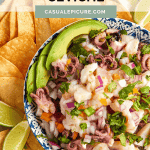This post may contain affiliate sales links. As an Amazon Associate, I earn from qualifying purchases. Please see my full disclaimer policy for details.
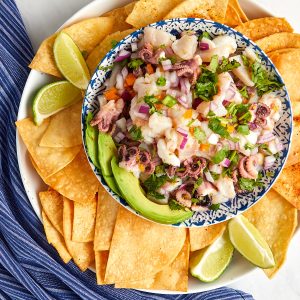
When summer rolls into South Texas, we are always looking for quick and simple dishes that are easy and lighter for the evening. A popular dish down here with our Mexican culinary influences is ceviche, often served with guacamole and chips. Ceviche can be as simple as lime-marinated fish or shrimp with some chiles for heat, or as extravagant as your ambitions and budget will allow. This recipe for octopus ceviche (or ceviche de pulpo) combines baby octopus with shrimp and tilapia for a bright and flavorful appetizer or light dinner.
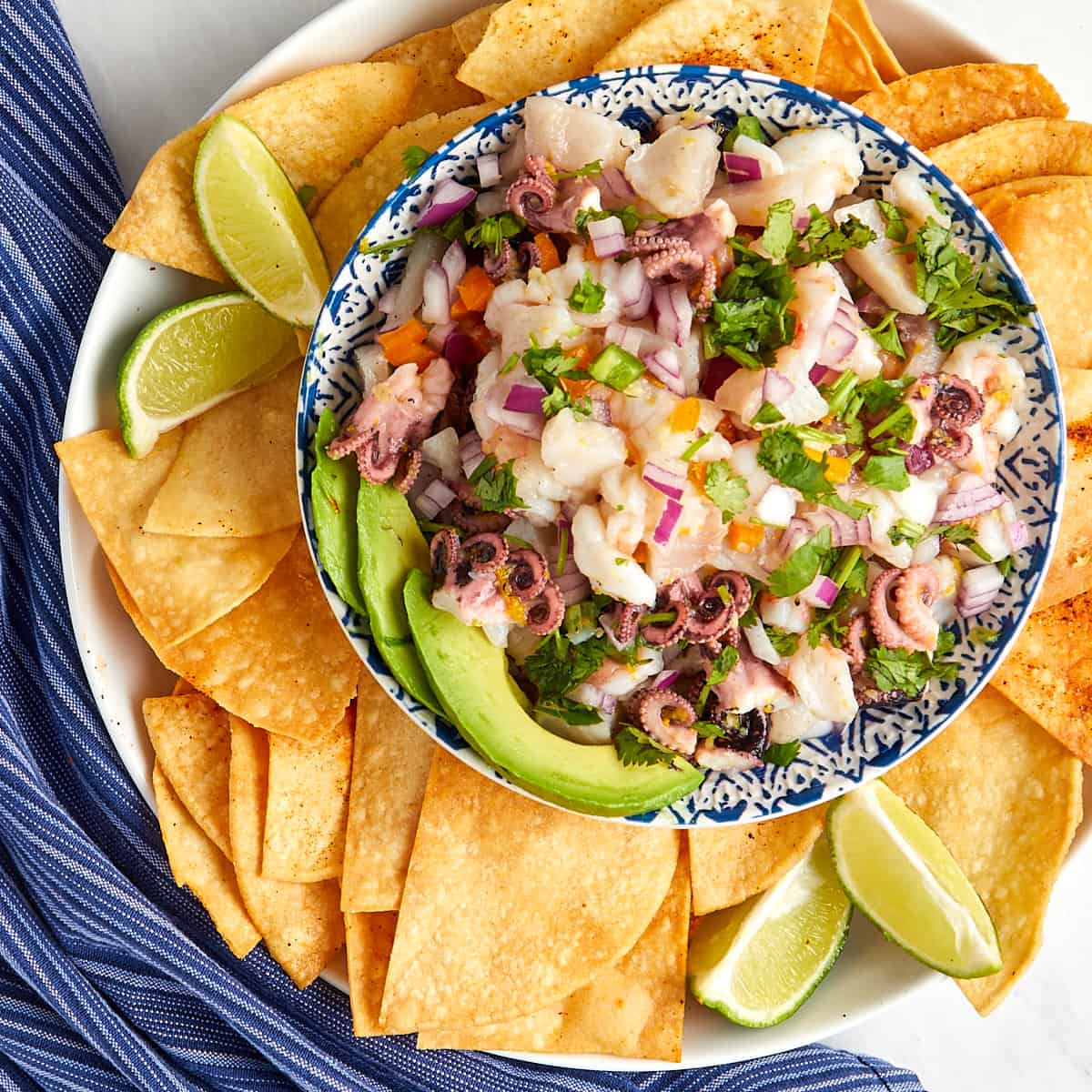
What is Ceviche
The origins of ceviche are hotly contested but was definitely popularized from the coastal regions of South America all the way up to the Pacific coast of Mexico. The essence of ceviche is fresh seafood chunks marinated in citrus juice with some savory ingredients, especially chile peppers. There are as many variations of ceviche as there are types of seafood. The first person to introduce it to me was my friend Alonso who was from Lima, Peru – and he would tell anyone who would listen that Peru invented ceviche, along with the pisco to wash it down. He included pulpo, or baby octopus, which he par-boiled before adding it to the firm white fish he had marinating in the fresh juice from seemingly countless limes. The citric acid interacted with the protein in the fish, turning the flesh opaque and firm after 20-30 minutes, and even though I was a bit leery, I gave it a taste and became a convert.
Key Ingredients and Substitutions
Ceviche is one of those dishes that you can experiment with until you find the exact combination of ingredients that works for you, but there are a few key elements that need to be present for it to honor this regional delicacy.
In the printable recipe below, you can find a complete list of ingredients and measurements.
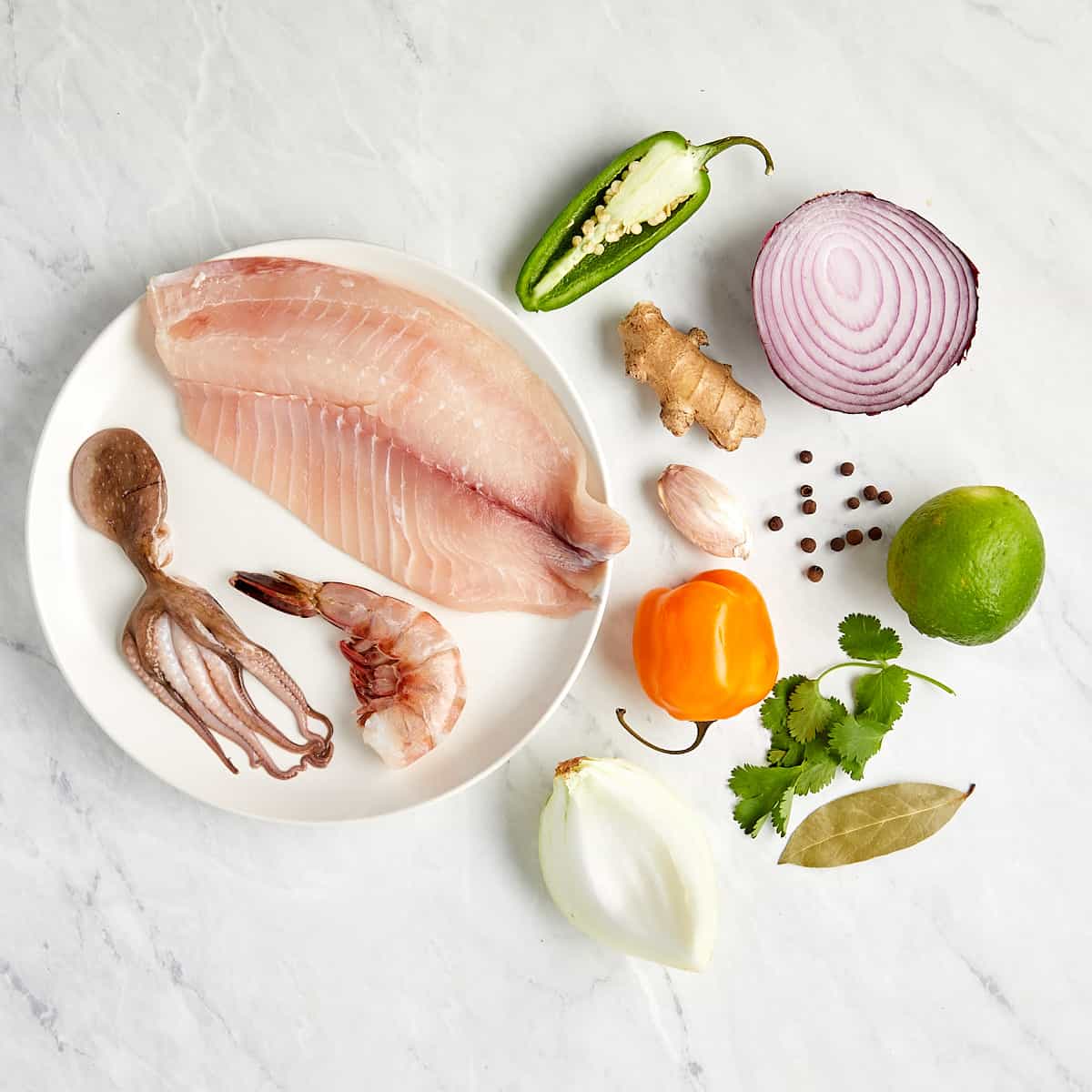
- Tilapia: There are many different fish that you can use including snapper, sea bass, halibut, mahi-mahi, or even flounder. If you’re buying fresh fish, ask your fishmonger what’s the freshest that they would recommend for ceviche. If you are going to use frozen fish, we’ve found tilapia to be an excellent option with a clean taste and firm flesh perfect for this preparation.
- Shrimp or other seafood: Fresh shrimp, scallops, lobster, or baby octopus are all great additions in proper proportions to the fish. The shrimp can be shelled and cut up into similar-sized pieces as the fish and can also be ‘cooked’ with just the acid from the citrus. Depending on how fresh the seafood is, you may be better off submerging it in boiling water for a minute or two before adding it to the raw fish for marinating, both from a food safety perspective and also your preference for texture.
- Lime Juice: The seafood needs acid to ‘cook’ the proteins in its flesh to achieve the right flavor and texture, and citrus is the most common. Buy more limes than you think you’ll need as you want the juice to completely cover all of the seafood. Sometimes we like to use lemons which have a mellower flavor, which is our preference when we have really fresh fish or seafood.
- Chili peppers: Not everyone will want to include this ingredient, but it’s a traditional addition to add some spice. Habanero is the most authentic, with its fruitiness complimenting all the other flavors, but it’s easy to overdo it as it’s quite spicy. Jalapenos could also be used, adding a more herbaceous note, but whatever pepper you use it should be fresh rather than dried if it’s going to blend with the other ingredients.
- Red onion & cilantro: These are our favorite ingredients to round out the overall flavor, but not everyone likes them. The citrus juice acts like a quick pickle on the red onion, so it mellows the flavor a bit. You could add any member of the allium family or fresh herb you like – it’s all a matter of taste!
How to Make Octopus Ceviche
Here are the quick step-by-step instructions with visuals; you can find the full instructions with the exact ingredients in the recipe card below.
This post may contain paid affiliate sales links. As an Amazon Associate, I earn from qualifying purchases. Please see my full disclaimer policy for details.
Pro-tip: Ceviche is all about the seafood, so this isn’t the dish to skimp on quality.
1. Prepare the octopi: Let the octopi soak in water for at least 5 minutes and then rinse well. Heat 2½ to 3 quarts of water in a large saucepan over medium-high heat. Peel and quarter the onion from the root to keep it together; peel the garlic slice in half lengthwise. Cut the chile into 1 – 1½ inch pieces and remove the ribs and seeds. Add the onion, garlic cloves, chile pepper, bay leaves, allspice, lemon juice, and salt and bring it all to a boil.
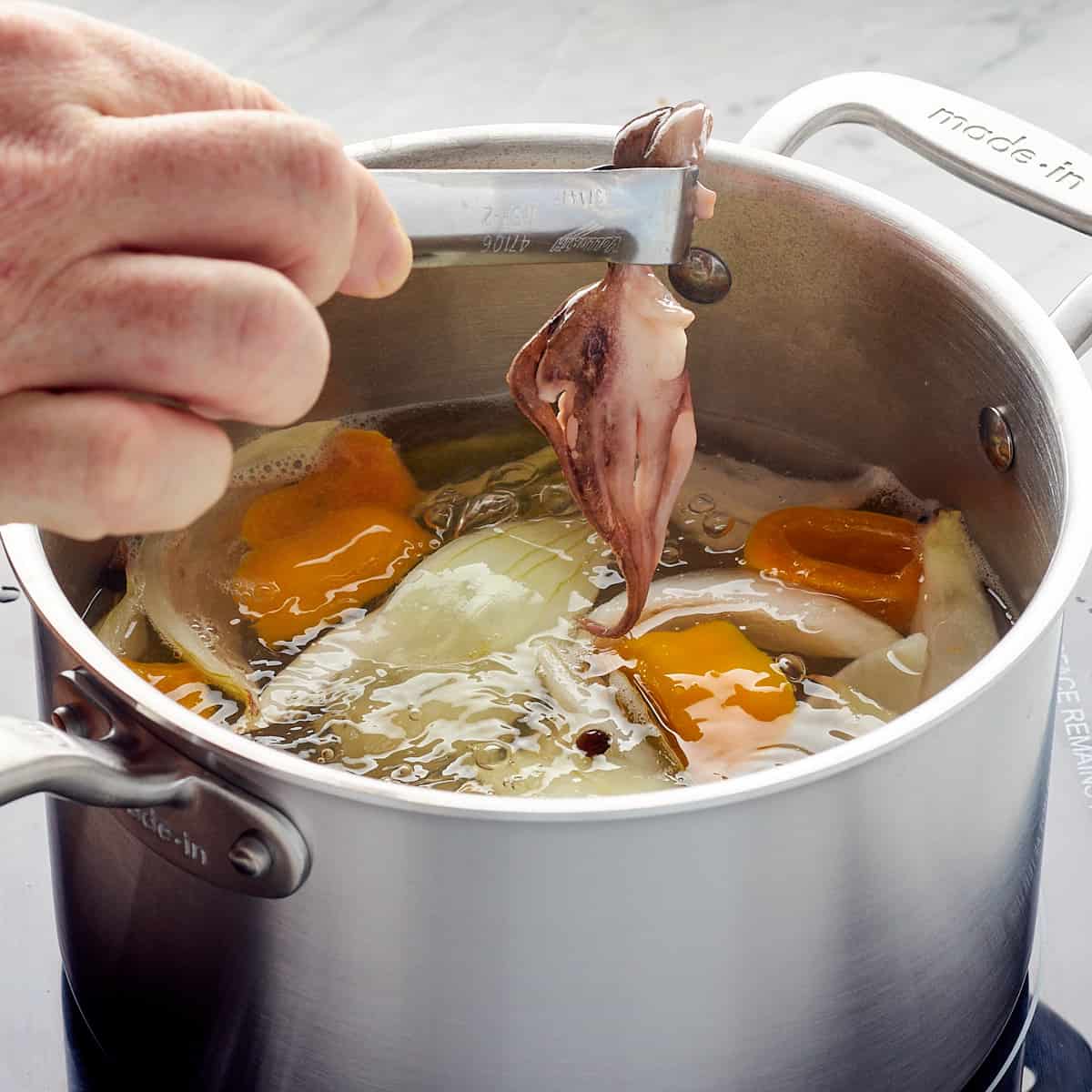

2. Prepare the octopi: Holding the octopus by the head insert the tips of the tentacles into the boiling broth for five seconds. Quickly remove the octopus, wait about ten seconds, then repeat until the tip of the tentacles begin to curl up. Repeat this process for the remaining octopus.
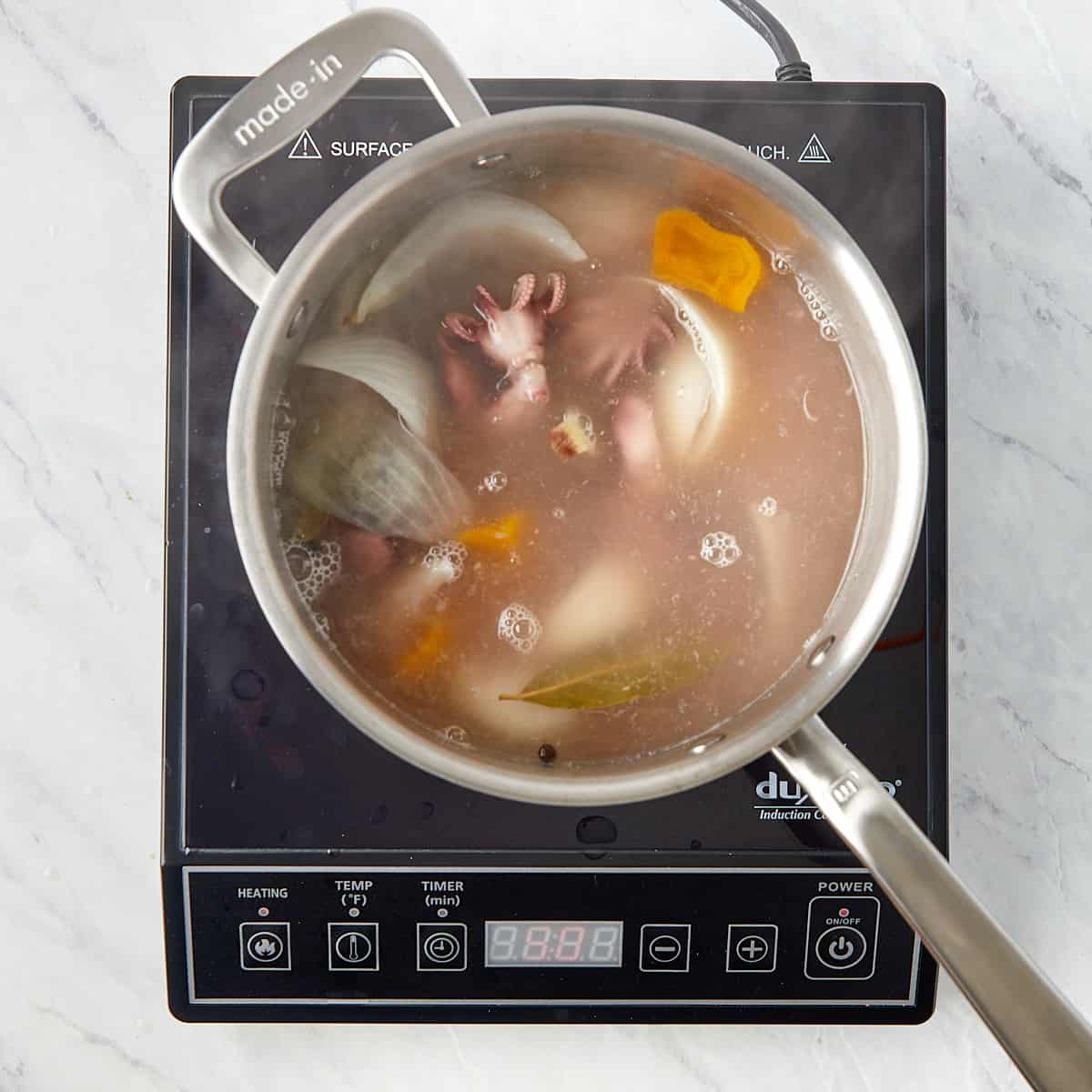
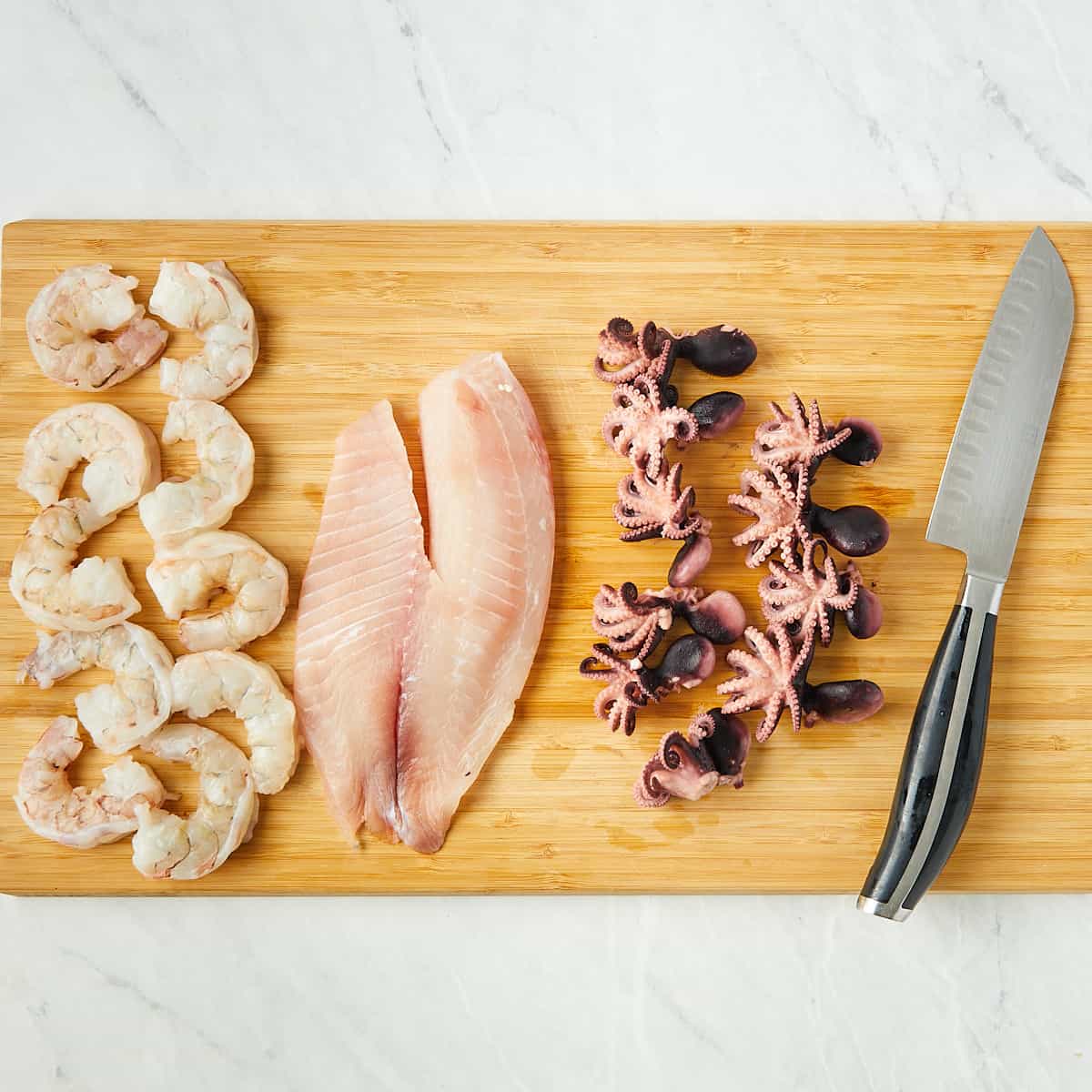
Add the octopus to the boiling water with the other ingredients, cover, and cook for 15 minutes. Octopus is done when the tentacles can be poked with a fork with little resistance. Check every 3-5 minutes to avoid overcooking. Using a spider or slotted spoon, remove all of the octopi from the pot and allow them to cool to room temperature in a bowl.

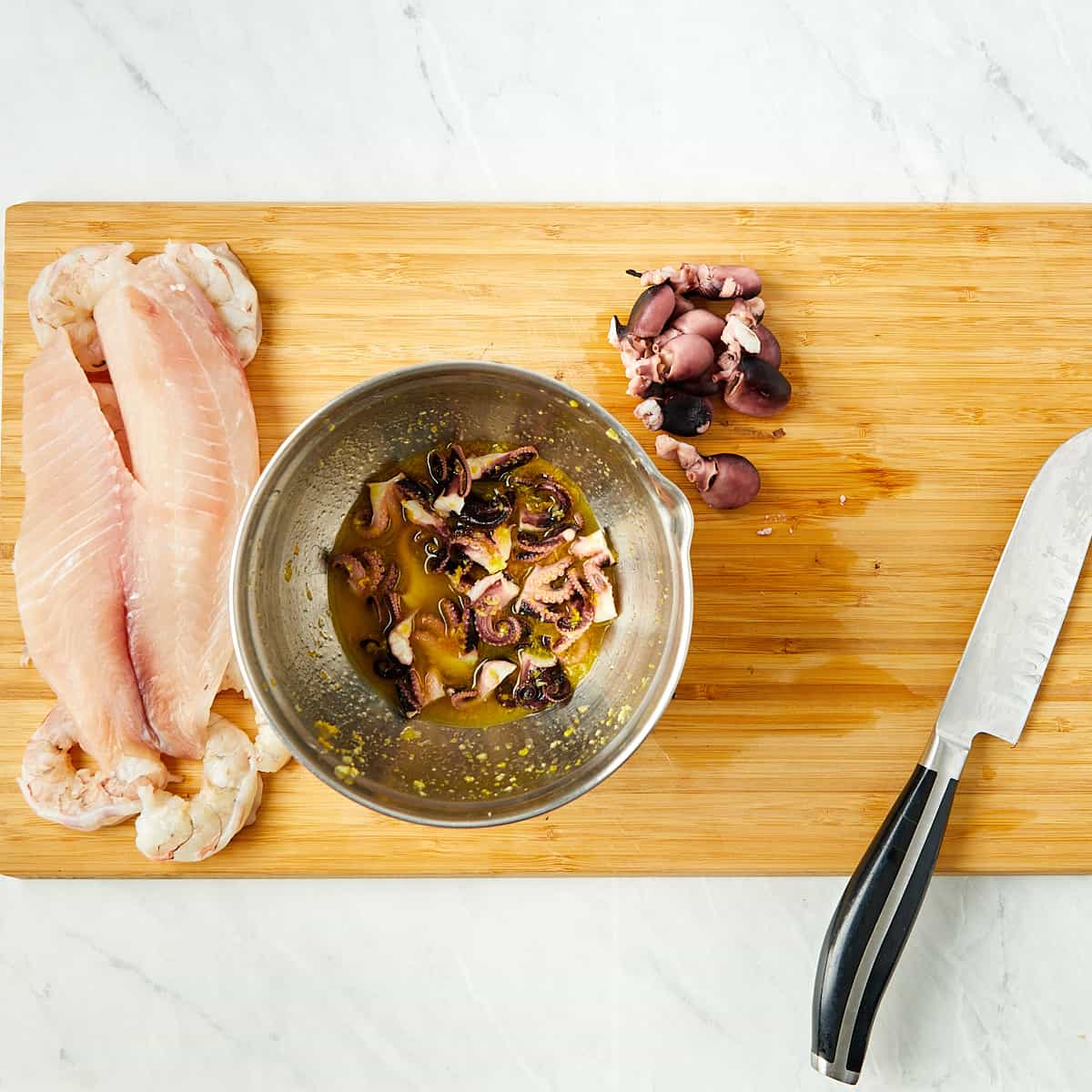
Once the octopi have cooled, cut off the heads and cut the tentacles in to smaller pieces. Add the cut tentacles to a bowl with the grated ginger, orange zest, and olive oil, tossing to cover evenly. Cover with plastic wrap and refrigerate.
3. Prepare the seafood: On a cutting board, cut the shrimp into 3-5 equal pieces depending on how large they are. You are looking for small bite size pieces. Cut the tilapia into similar-sized pieces. Place the shrimp and tilapia in a bowl and then cover with fresh squeezed lime juice. Stir to evenly coat the seafood. Cover the bowl with plastic wrap and refrigerate for 20 to 30 minutes, gently stirring the seafood mixture every 10 minutes.
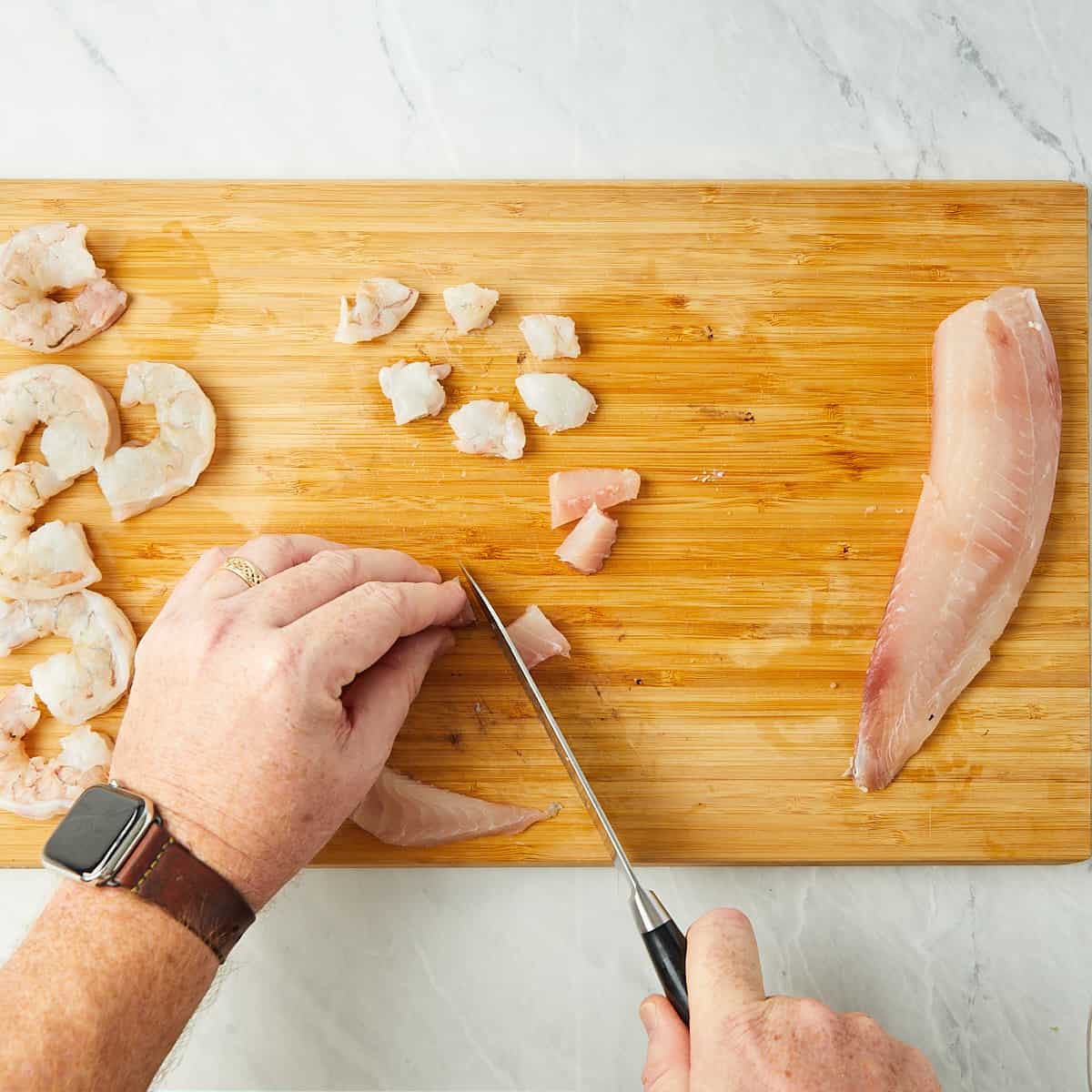
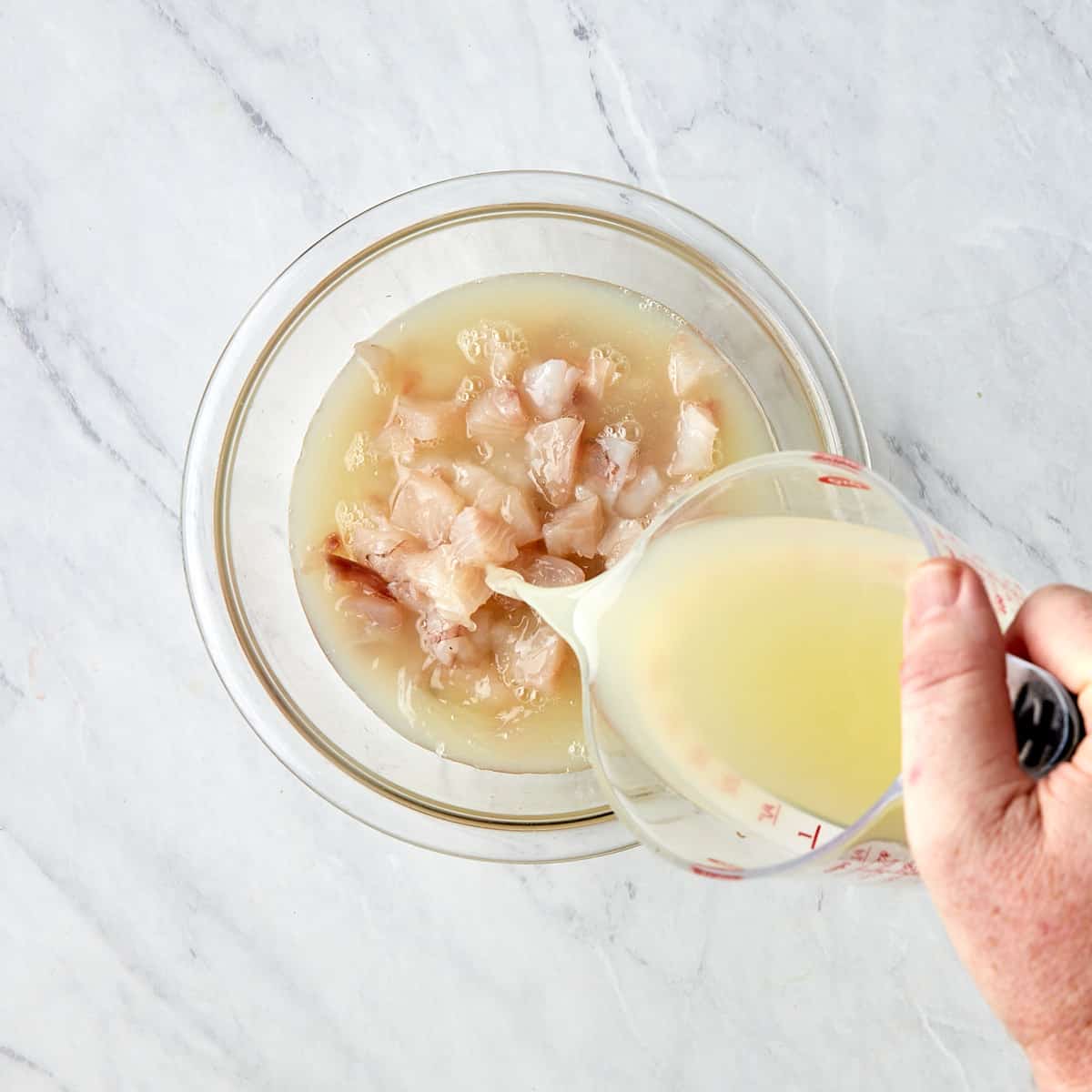
4. Assemble and serve: Strain out the lime juice from the shrimp and tilapia mixture and add the baby octopi, red onion, minced chili, and cilantro. Mix well. Serve immediately with tortilla chips, guacamole, and wedges of lime.

What to Serve with Seafood Ceviche
Seafood ceviche is the perfect appetizer or a light dinner. We serve ceviche with homemade totopos (or tortilla chips) or on tostadas along with guacamole and salsa or pico de gallo. And don’t forget the refreshments –margaritas are the perfect ceviche cocktail.
Make-Ahead and Storage
Make-Ahead: Ceviche is best when freshly made and can be made up to 4 hours in advance of serving, although you may want to drain most of the lime juice after an hour to avoid your fish getting tough.
How to Store: If are wanting to store leftover ceviche, it is best to drain the lime juice from the prepared ceviche to prevent the fish from “overcooking”. Ceviche should be safe to eat for up to two days if stored in an air-tight container in the refrigerator.
Recipe Tips and Notes
- Do not over-cook the seafood. Although this isn’t technically cooking, as the acid reacts with the protein in the seafood it ‘cooks’ it. The texture will change from raw and squishy to firm and opaque – and if left too long it can be tough and chewy. Only add the octopi right before serving.
- Use freshly squeezed citrus juice. Many food markets now offer fresh lemon and lime juice that was squeezed that morning or the day before. This is a great option, but it’s cheaper to just buy the citrus and do it yourself. Definitely don’t use any ready-made juice that is in the aisle with other juices since it will have a different flavor than fresh which will be imparted to the ceviche itself.
- Cut the seafood into small, bite-sized pieces. Ceviche is often served with totopos, or homemade tortilla chips, so the size of the pieces needs to be conducive to scooping. This will also allow for more balance between the different types of seafood, plus leave room for some of the onion, chile and cilantro.
- Use fresh seafood from a trusted fishmonger. The freshness of the seafood is the biggest determining factor in how tasty the ceviche will be. Ask your fishmonger (or the person behind the seafood counter in one of your ‘better’ grocery stores) which fish are the freshest and would be good for ceviche. If you don’t live anywhere near an ocean, you may want to consider frozen shrimp and tilapia since they are often frozen right after being caught. Defrost them in the refrigerator to preserve the best possible texture.
Frequently Asked Questions
That depends on your perspective – the citrus acid definitely reacts with the protein in the seafood, changing the texture and flavor. This is an analog to ‘cooking’ with heat… but if you’re especially squeamish about raw food, this may not be for you. If you are worried about parasites or bacteria, you can also opt to quickly blanch your seafood in boiling water.
While the preparation of ceviche is an effective method to reduce bacteria it does not eliminate all bacteria or other pathogens.

More Seafood Recipes To Try
Looking for more inspired seafood recipes? Try these other favorites:
- Hawaiian Style Ahi Tuna Poke Bowl – Made with sushi grade ahi tuna, soy sauce, sesame oil, oyster sauce, and scallions served over rice and topped with sesame seeds.
- Crab and Ahi Tuna Tower – Layers of delicious crab meat, mango and avocado, and sushi-grade tuna create this restaurant worthy recipe that will easily elevate your next at-home dining experience. It is a perfect shareable appetizer.
- Sesame Seed Crusted Tuna Steak with Mango Salsa – Seared Tuna with a sesame seed crust topped with fresh mango salsa. Healthy, delicious dinner ready in less than 30 minutes.
Let’s Connect! If you make this recipe or any other recipe on Casual Epicure, please don’t forget to rate the recipe and leave a comment below. It helps others who are considering making our recipes and we love hearing about your cooking experiences. And if you snapped some shots, share them on Instagram, and be sure to tag @casual.epicure so we can feature them in our stories.
Octopus Ceviche
This recipe may contain paid affiliate sales links. As an Amazon Associate, I earn from qualifying purchases. Please see my full disclaimer policy for details.
Equipment
- Spider or Slotted Spoon
Ingredients
Baby Octopus
- ½ pound baby octopus
- 1 white onion, medium
- 3 garlic cloves, peeled
- 1 chile pepper, seeds removed
- 2 bay leaves
- 5 allspice berries
- 1 teaspoon ginger, freshly grated
- 1 teaspoon orange zest
- 1 tablespoon olive oil, extra virgin
- ¼ cup cilantro, chopped
Shrimp and Fish
- ½ pound shell-on shrimp
- ½ pound tilapia filet
- 1 ½ cups lime juice, fresh squeezed
Seafood Ceviche
- ½ cup red onion, chopped
- 1 ½ tablespoons chile pepper, minced
- 1 teaspoon kosher salt
- ½ teaspoon black pepper, freshly cracked
Instructions
Baby Octopus
- Let the octopi soak in water for at least 5 minutes and then rinse well.
- Peel and quarter the onion from the root to keep it together; peel the garlic slice in half lengthwise. Cut the chile into 1 – 1½ inch pieces and remove the ribs and seeds.
- Heat 2½ to 3 quarts of water in a large saucepan over medium-high heat. Add the onion, garlic cloves, chile pepper, bay leaves, allspice, lemon juice, and salt. Bring to a boil.
- Holding the octopus by the head insert the tips of the tentacles into the boiling broth for five seconds. Quickly remove the octopus, wait about ten seconds, then repeat until the tip of the tentacles begin to curl up. Set aside and repeat for the remaining octopus.
- Add the octopus to the boiling water with the other ingredients and cover. All to cook for 15 minutes. Octopus is done once the tentacles can be poked with a fork with little resistance. Check every 3-5 minutes to avoid overcooking.
- Using a spider or slotted spoon, remove all of the octopi and let cool to room temperature in a bowl while preparing the other seafood.
- Once the octopi have cooled, cut the heads from the tentacles and cut the tentacles in half. Add the tentacles to a bowl with the grated ginger, orange zest, and olive oil, tossing to cover evenly. Cover with plastic wrap and refrigerate.
Shrimp and Fish
- Shell and devein the shrimp then rinse thoroughly.
- On a cutting board, cut the shrimp into 3-5 equal pieces depending on how large they are. Cut the tilapia into similar-sized pieces.
- Place the shrimp and tilapia in a bowl and cover with the fresh squeezed lime juice. Stir to evenly coat the seafood. Cover the bowl with plastic wrap and refrigerate for 20 to 30 minutes, gently stirring the seafood mixture every 10 minutes.
Seafood Ceviche
- Strain out the lime juice from the seafood mixture and add the baby octopi, red onion, minced chili, and cilantro. Mix well.
- Serve immediately.

